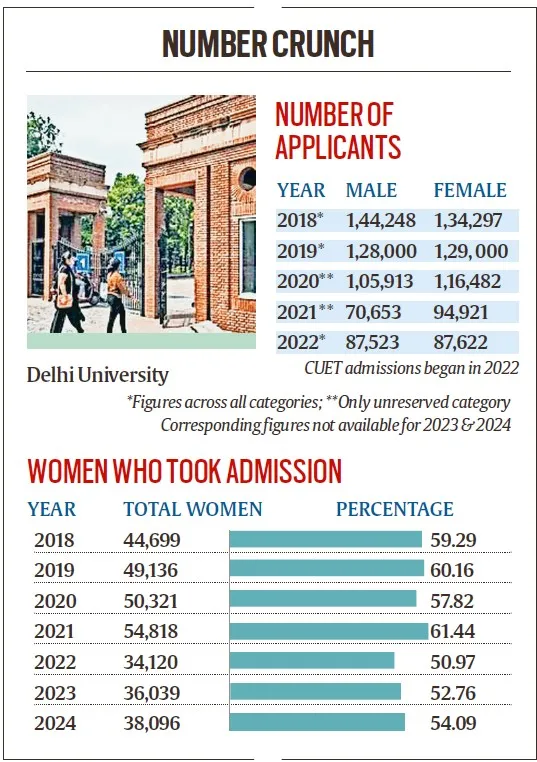Why Female Enrolment at Delhi University Has Dropped Since CUET?

Since the launch of the Central University Entrance Test (CUET) in 2022, Delhi University (DU) has seen a significant decline in the number of women enrolling in undergraduate courses. Official data points to a stark gender shift in the student population post-CUET implementation.
In 2021, the year before CUET was introduced, 54,818 women were admitted to DU’s undergraduate programs. This number dropped sharply to 34,120 in 2022, the first year of the centralised test. While there has been a modest recovery — with 36,039 women enrolling in 2023 and 38,096 in 2024 — the figures remain well below pre-CUET levels.
Admission Model Shift: Cut-Off to CUET
Prior to CUET, DU admissions were based on Class XII Board results through a cut-off list system. All students meeting the cut-off were granted admission, regardless of the number of available seats. This allowed more flexibility and access, especially for high-performing students from diverse backgrounds.
CUET introduced a centralised, competitive entrance exam, which reshaped admission dynamics — especially affecting gender ratios.
Gender Ratio Shift at Delhi University
The impact of CUET on gender representation has been substantial. In 2021, women comprised 61.44% of DU's undergraduate student body. By 2024, this dropped to 54.09%, indicating a decline in female representation in just three years.
Overall Admissions Also Declined Initially
CUET’s first year saw an overall admission slump at DU. Total UG admissions dropped from over 75,000 in 2018 to just over 64,000 in 2022. This was followed by a slight increase — over 68,000 in 2023 and over 70,000 in 2024.
Pre-CUET Trends: More Female Applicants
Between 2019 and 2021, DU consistently recorded strong female participation in undergraduate admissions. In 2019, 1.29 lakh women applied, surpassing 1.28 lakh men. In 2020, within the unreserved category, 1.16 lakh women applied compared to 1.05 lakh men. The trend peaked in 2021 with 1.49 lakh applications from women against 1.37 lakh from men.
CUET 2022: Equal Applicants, But Lower Enrolment
Even in 2022 — CUET’s first year — registration numbers at DU were nearly equal, with 87,622 women and 87,523 men applying. Despite this, fewer women ended up securing seats.
Interestingly, women registering for CUET-UG nationally have been on the rise: from 4.29 lakh out of 9.68 lakh total applicants in 2022 to 6.47 lakh out of 13.54 lakh in 2024.
What’s Causing the Gender Gap?
Experts suggest that centralised entrance exams like CUET create pressure to rely on coaching institutes. This puts female students at a disadvantage, as families — especially in conservative or low-income settings — are often less willing to invest in coaching for daughters.
Moreover, limited access to digital devices further widens the gap. In many parts of India, girls have less access to smartphones, laptops, or internet connectivity, which impacts their preparation for online-based exams like CUET. Boys, on the other hand, are more likely to visit cyber cafés or study hubs to practise for such exams — a freedom not always available to girls.
An alternate explanation also suggests that the centralised nature of CUET is offering students more choices, leading many girls to opt for colleges closer to home, thus lowering enrolment at larger urban universities like DU.
Conclusion
The decline in female enrolment at Delhi University post-CUET reflects a complex intersection of gender, access, digital literacy, and socio-economic factors. While CUET has streamlined admissions, its broader impact on inclusion — especially for women — requires urgent policy attention.

